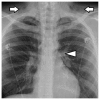Pneumorrhachis after Recreational Drug Use
- PMID: 29875991
- PMCID: PMC5965289
- DOI: 10.3941/jrcr.v12i4.3103
Pneumorrhachis after Recreational Drug Use
Abstract
Pneumorrhachis, the presence of air in the spinal canal, is an unusual and alarming radiographic finding. The etiology is most commonly traumatic or iatrogenic but it can occur as a spontaneous phenomenon in association with pneumomediastinum. We report the case of a 16 year old male who presented with throat discomfort and a feeling of altered voice after recreational drug use. Examination confirmed widespread subcutaneous emphysema above the clavicles and plain radiograph and computed tomography imaging confirmed the presence of extensive pneumomediastinum and pneumorrhachis. The patient was managed conservatively and made a full recovery. The clinical and imaging features of spontaneous pneumorrhachis are presented as well as a review of the literature with regard to pathogenesis, management and outcome. Knowledge and understanding of this unusual phenomenon is important to properly direct patient care.
Keywords: Pneumorrhachis; computed tomography; diagnosis; imaging; intraspinal air; spinal pneumatosis.
Figures






References
Publication types
MeSH terms
Substances
LinkOut - more resources
Full Text Sources
Other Literature Sources
Medical

